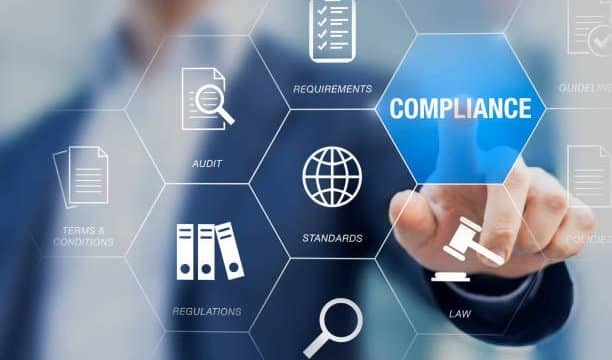Companies are required to navigate a complex network of regulatory compliance. It is imperative to comply with numerous rules, guidelines, and requirements, not only as an option but as a crucial element for survival. This article delves into the world of regulatory compliance, examining its many facets. It also emphasizes the significance of Know Your Business (KYB) compliance in the process of business verification. Understanding these vital components in today’s ever-changing business environment is essential for maintaining transparency, reducing risks, and achieving success.
Table of Contents
What is Regulatory Compliance?
Regulatory compliance is like playing a game of Jenga in the business world. Each block represents a law or regulation; removing or ignoring one could cause the entire structure to crash. Just as in the corporate world, it’s important to carefully and strategically follow the rules to ensure stability and success.
Difference Between Compliance Risk and Regulatory Risk?
While appearing similar, compliance risk and regulatory risk hold distinct meanings. Compliance risk refers to the potential harm and legal consequences arising when a person or organization fails to follow laws or regulations. Regulatory risk pertains to the potential impact of alterations in laws and regulations on a business’s day-to-day activities. This factor can substantially threaten a company’s stability as regulatory changes may drastically alter the playing field, requiring businesses to adapt quickly, and efficiently to remain compliant.
What are the Types of Business Regulations?
In today’s market, there are various business regulations that create a level playing field for all companies, ensuring fairness and equality. To achieve Know Your Business (KYB) compliance and maintain business verification processes, it is essential to be knowledgeable about labor and environmental regulations, advertising-marketing laws, and privacy laws. Rules ensure fairness and safety in business practices, a good reputation ensures trust and loyalty from customers or stakeholders. Both are important for the long-term success of a business.
How to Spot Regulatory Risks?
Having sharp attention to detail is necessary when identifying potential regulatory risks. Businesses must perform routine audits to guarantee adherence to regulatory mandates. Keeping abreast of any modifications to laws and regulations is crucial to evade possible risks. Additionally, implementing Know Your Business (KYB) monitoring can help identify potential regulatory risks and prevent legal issues. By taking these precautions, businesses can ensure that they are operating within the bounds of the law and avoid any costly legal repercussions.
What is the Business Verification Process?
A key aspect of KYB compliance or the business verification process, involves verifying a company’s legal status, the authenticity of its operations, and its regulatory compliance. This process is essential to prevent business-related fraud and maintain transparency.
There are many rules that businesses have to follow to make sure they’re doing things correctly. Not following these rules may result in trouble for them. Some of the rules have to do with ensuring institutes report their finances correctly, keeping people safe and healthy while taking care of the environment.
Risk Management Mechanism for Compliance
Risk management for compliance includes:
- Implementing controls to mitigate risks.
- Conducting regular audits.
- Maintaining documentation for all compliance-related activities.
It often involves leveraging technologies to automate the compliance process, which leads to higher efficiency and reduced human error.
How to Improve Regulatory Compliance?
Improving regulatory compliance can be achieved through regular training of employees, keeping abreast of regulatory changes, improving internal controls, and continuously monitoring compliance.
How to Reduce Compliance Risk with Software?
Compliance risk can be significantly reduced with software solutions. These tools automate compliance procedures, provide real-time insights, and facilitate efficient regulatory reporting, hence helping businesses meet regulatory compliance obligations more effectively.
What are the Benefits of Compliance Software?
Compliance software brings numerous benefits, such as streamlined processes, reduced human error, real-time reporting, and the ability to track and manage regulatory changes. This offers a simplified approach to managing the intricacies of regulatory compliance.
Tips for Selecting the Top Regulatory Compliance Software
When it comes to selecting the most suitable regulatory compliance software for your business, it is crucial to assess several key factors:
- It is essential to assess the software’s capabilities to ensure they are in accordance with your compliance needs.
- Consider ease of use and customization when evaluating software to ensure it’s user-friendly and meets your needs.
- Verifying that the software can seamlessly integrate with any existing systems you have in place.
When you take into account these factors, you can choose a regulatory compliance software that will effectively handle your business’s distinct regulatory requirements with confidence.
What is Compliance Risk Management?
Managing compliance risk involves recognizing, controlling, observing, and mitigating the compliance risks confronted by an organization.
The Bottom Line
Businesses must adhere to the rules and regulations that apply to their operations. This can involve things like ensuring they’re doing everything right, checking that their customers are who they say they are, and verify they’re following the rules concerning money laundering and fraud. By using special software to help them with all of this, businesses can make their work smoother, reduce risks, and keep everything running smoothly.




